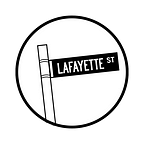Vanguardist fashion in the 90s
Art is full of counter-movements. The tendency of creating something new as a proposition of the status quo is not indifferent in fashion too. In the 80s, the fashion scene was set in Paris. Glamour, slim silhouettes, femininity, and color were the trend. Chanel was defining the industry collection after collection and probably the only one doing something different was Gianni Versace in Miami, but certainly following the same standards.
Everything changed when Rei Kawakubo and Yohji Yamamoto moved to Paris. These two Japanese designers arrived in the fashion capital with new ideas that changed the fashion world as people knew it. The duo arrived in Paris in the late 80s and as Kawakubo said: let’s get rid of folklore and tradition and let’s do something new. Their conceptual fashion went far from the Parisian standard and it was much darker, interesting, and harder to understand. They got rid of the traditional silhouettes and transformed the human body into a blank canvas that would wear art pieces. They transformed the catwalks into installations in which they sent their message through visuals, music, and of course the centerpiece, the clothes. Surely, at first, they were not accepted, but they initiated a movement, that opened a door for designers that looked to them to do something similar and be considered mainstream.
In the late 80s, in Belgium, young designers known as the Antwerp six were already working on the new concepts of fashion. Inspired by the movement started by Kawakubo and Yamamoto, the Belgians led by Ann Demeulemeester and Dries van Noten were motivated to change the status quo of fashion. Influenced by the cultural and social environment in Europe, their designs were very grunge. Textures, draping designs, and spaces left for partial nudity were some of the most important remarks of their style. Probably one of the most important designers of that era was Martin Margiela. His staple was a bit different. He wanted to recycle old things, paint them over, and reuse them to create designs out of nothing. Heavily criticized, but collection after collection his style started to gain respect. Margiela’s impact was not only design but once again he redefined the concept of the catwalk. He designed it as a social gathering. A place made for people to enjoy fashion. Probably the most remembered show was one that took place in his studio in Paris, gathered the chicest and most influential people in the industry (like Anna Wintour), served them red wine in plastic cups, and did not even show his clothes but rather showed a video showing the designs.
This boom of new designers changed the up and coming fashion of the 1990s. The 80s were about wearing clothes to astonish people while the 90s where more about wearing clothes to express oneself. Another big impact of independent fashion in the industry was the use of supermodels. The boom of supermodels in the 1990s made them celebrities. Brands now used figures like Kate Moss and Naomi Campbell to sell by using their names. On the other side, the anti fashions looked for new models. Women that instead of having big names, represented the values and identity of their brands.
The next stylistic concept that hit the runways was minimalism. Structured silhouettes, earthy tonalities, and boxy structures. They took inspiration from their predecessors but took a more chilled direction. The major personalities from this movement like Jill Sander and Helmut Lang offered their style to this new customer that wanted to represent vanguard fashion and became wildly popular. The big conglomerates realized that there was a shift in fashion and started hiring independent designers in their houses to supply the demand for alternative fashion. That’s the reason why we saw Marc Jacobs working for Louis Vuitton, Tom Ford for Gucci, and most importantly Alexander Mcqueen for Givenchy. The appropriation of the big conglomerates of independent designers in the early 2000s marked the end of this era of fashion and brought the vanguard into the mainstream. Maybe the only designer that kept the stylistic inspiration from the vanguard of the 90s was Rick Owens, that today stands out once again for being something else.
